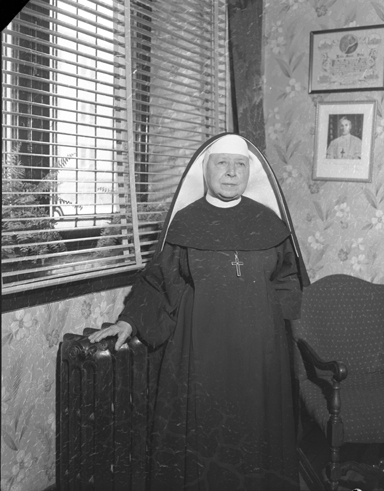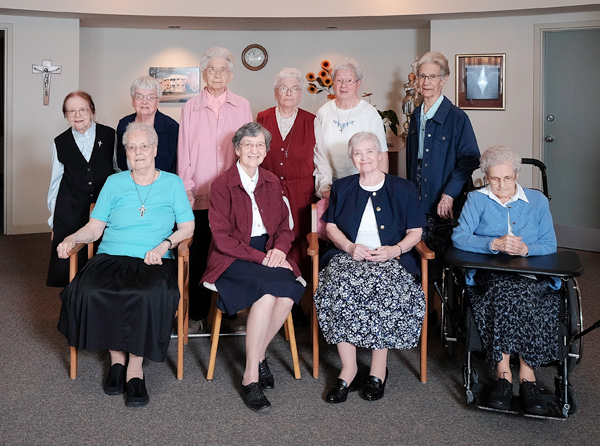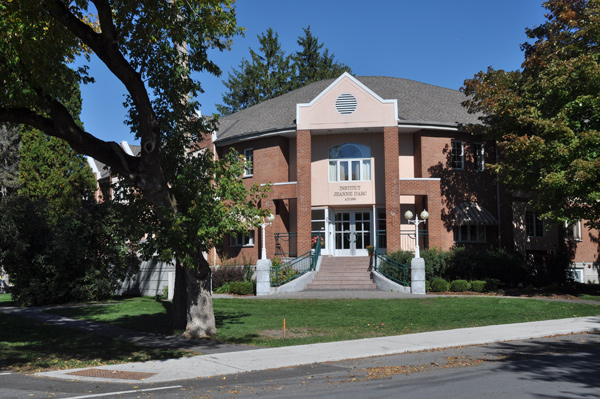By Alyson Queen –
Many know that Les Soeurs de l’Institut Jeanne d’Arc (Sisters of the Joan of Arc Institute) have lived in a residence on Princeton Avenue since 2006. But few know who they really are.
It has been a humbling experience to learn about the 11 women who remain in the convent and hear their stories as they prepare to leave Westboro at the end of November.
These are women who do not seek accolades or public recognition. They serve God, pray daily, and serve others. But they have had a profound impact on thousands of young women and on our community.
How it all began
The convent was founded in 1919 by Sister Marie Thomas d’Aquin. Born in France in 1877, she served as Mother Superior until 1943. Creating the only francophone order of women in Ontario, she carved out a focus to provide care for young women and deliver quality education.
Sister Marie Thomas d’Aquin was a poet herself, but often used the following verse by Walter Foss to explain the mission to the sisters: “Let me live in a house by the side of the road, and be a friend to man.”

Since its early days, l’Institut Jeanne d’Arc has been a residence and home-away-from-home for thousands of young women. They came from countries around the world – from all backgrounds and religions – to stay with the sisters while searching for work, obtaining language skills or studying at college or university. In the early 2000s, young women representing 12 countries were staying in residence.
Teaching was complementary to the mission. La Maison Jeanne d’Arc, now a heritage property on Kenwood Avenue, was started in 1932 and completed in 1934. Under the leadership of Sister Marie Thomas it became a primary boarding school, known as l’École de la Maison Jeanne d’Arc or Joan of Arc Private School. There, young students would attend until Grade 6 and emerge perfectly bilingual. The boarding school evolved into Ottawa’s first fully bilingual primary day school in 1954, which operated until 1991.
Sisters of the Institute taught elsewhere in Ottawa, as well as in Quebec and in the United States. The Institute also eventually opened young women’s residences in downtown Ottawa, Montreal, Rouyn-Noranda, Gatineau and even in a small Brazilian village called Guarulhos close to San Paulo.
With time comes change
At its height in the 1960s, there were nearly 150 sisters in the order. But that height came when society was transforming. A number of changes were handed down from the Vatican, including that the sisters no longer had to wear official religious robes on a daily basis.
Recruitment was falling. Once the school closed in 1991, growth of the order came to an end. Yet, the situation for the sisters of l’Institut Jeanne d’Arc is not unique. There have been sharp declines in religious orders throughout North America and Europe. What’s interesting is that these declines are not global. Religious vocations in Latin America, Africa and the Philippines are actually on the rise.
When asked about the broader state of religious orders, like hers, Sister Yvette Papillon, Superior General of the Order, pauses.
“It’s a big question that I cannot [fully] answer,” she says. “They say we have about 600 new religious congregations worldwide. So God always calls. The format is just different.”

Each story is unique, yet connected
There is no question that dedicating one’s life to a cause requires discipline and commitment. When that cause is the Church, unflinching faith is the cornerstone.
“Choosing a religious vocation is an answer to God’s call, to His love,” explains Sister Yvette.
Sister Elizabeth Bujold, at 104 years old, is the eldest of the eleven remaining sisters. Her faith has seen her through incredible changes in society, technology, the Church and her order.
“When we first came here, it was like we were in the woods. Westboro was the country,” she remembers.
As a cook, she worked for years in La Maison Jeanne d’Arc on Kenwood Avenue, serving meals to hundreds of young women and literally keeping the home fires burning in the kitchen stoves and furnace.
In many ways, it is Sister Elizabeth who, more than anyone, has seen the life cycle of the order. She entered in 1932, just as La Maison Jeanne d’Arc was being built and the order was young, new and inspired. In a month, she will witness its final chapter unfold.
Sister Denise Montpetit also reflects on countless stories of the many young students and residents she has met over the years.
“I taught for 30 years, primarily second grade, which was my favourite. I adored teaching. My English was also poor when I started so the children learned French (from me) and I learned English (from them).”
She also hears from previous residents, who often come to visit or update her with their stories.
Sister Monique Côté, originally from Boston, Massachusetts, landed in Ottawa not knowing whether she would stay. That was in 1962 and she has been here ever since.
After an hour or so of revisiting the past with stories – each one unique, each one special – Sister Yvette sums things up. It is as if a thread connects all of them. The mission given to each of them is based on the principles of friendship and always having an open door and heart. Those threads bind them even closer today.
Almost poetically, Sister Yvette muses, “be a friend in joy, in sorrow – without regard to differences, without asking anything in return – freely and openly.”
The future of Princeton Avenue
The sisters all feel a strong connection to Westboro. “This is our home,” says Sister Doris.
Indeed, their presence has been quietly yet strongly felt for a number of years.

The community returned the favour a decade ago, by pushing for a heritage designation for the original portion of La Maison on Kenwood. It was argued that it should be preserved not just for its history but also because it is one of the earliest examples of a building in Ottawa (and perhaps Canada), designed by a woman.
The plaque mounted on the Kenwood home, now developed into apartment units, is a testament to part of the legacy they leave in the area. The last remaining 22 sisters in the order moved into the property at 373 Princeton Ave. in 2006 and 11 sisters currently remain there. They are determined to ensure that the building not just be considered a property for sale, but be used to fulfill their mission of helping young women.
“The life of Mère St-Thomas represents one of unconditional love, every day. That’s the legacy she left for her community, for the Church and for society,” says Sister Yvette.
Although careful not to provide too many details, she says “everything is on track to conclude a sale at the end of November.”
She also confirms that they are working to ensure their legacy for the residence and surrounding property. “Our dream and wish is that l’Institut Jeanne d’Arc be converted into a space that will benefit the community, for years to come.”
“I am pleased to see that the sisters are seeking to have the existing residence used for supportive housing,” says Kitchissippi Ward Councillor, Jeff Leiper. “It speaks volumes about where their hearts are.”
There will certainly be ample opportunity for consultation on a proposal, once the time comes. Councillor Leiper says he is “looking forward to working to ensure it is to the community’s benefit, recognizing there is always a balance between welcomed development and over-intensification.”
The community will also have an opportunity to purchase a souvenir as well, as the sisters are planning a moving sale in mid-November.
Preparing for farewell
It clearly is a time of reflection for all of the sisters, Sister Yvette in particular.
“You can understand our sorrow [about leaving] because it feels like we are uprooting from this beautiful neighbourhood of Westboro that we love. It is difficult to process and accept.”
She acknowledges the reality that they face. Their order is getting smaller and they are getting older, with all of the women now retired and a number requiring special care. The demands of owning and managing a large property have become too much.
The other sisters have accepted this reality as well. They know that walls, bricks and mortar are just that. Yet they also acknowledge that this building has been home. They will also be saying goodbye to an extended family of caregivers.
Importantly though, the eleven women will move together and stay together, as they will be renting space with another order, Les Filles de Sagesse (Daughters of Wisdom).
With a dash of humour in a bittersweet time, Sister Elizabeth bluntly reminds us that although they will all still be in the same downtown building, she will be on a different floor, so the others will simply have to “take a trip to come see her.”
Leaving with legacy, guidance
Near the end of the afternoon, reflecting further on the coming weeks, Sister Yvette speaks of legacy.
“If you look closer, the roots of our past are strong and will not be cut because we carry them in our hearts. We are leaving a place but we are not leaving what we have sown and built from 1934 to 2016.”
They will also be taking some time in mid-October to celebrate their history more formally with a special, private event at their residence that includes a number of dignitaries.
Speaking about the next steps, Sister Thérèse quietly states: “Il nous guide.” He guides us. Her soft-spoken words hold a conviction that resonates in the bright room. All of the sisters nod in agreement.
Sister Yvette confirms, “God leads us. Life leads us.”